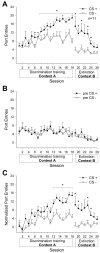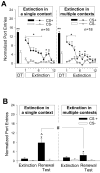Context-induced relapse of conditioned behavioral responding to ethanol cues in rats
- PMID: 18423574
- PMCID: PMC2556990
- DOI: 10.1016/j.biopsych.2008.03.007
Context-induced relapse of conditioned behavioral responding to ethanol cues in rats
Abstract
Background: The environmental context in which drug-conditioned cues are encountered could modulate the capacity of such cues to trigger relapse in abstinent addicts. We explored this hypothesis using a behavioral animal model.
Methods: Rats were trained to discriminate between two auditory stimuli; the first (CS+) was paired with 10% ethanol and the second (CS-) was presented without ethanol. Training occurred in operant conditioning chambers equipped with distinct contextual stimuli, and entries into the ethanol delivery port during the stimuli were measured. Behavior was then extinguished by presenting both stimuli without ethanol in a second, different context. Context-dependent renewal of port entries was tested by presenting the CS+ and CS- without ethanol in the original training context.
Results: At test, port entries during the CS+ increased compared with extinction levels, while responding during the CS- remained unchanged (n = 11). This effect was attenuated after multiple extinction sessions in three distinct contexts (n = 18), compared with an equivalent number of extinction sessions in a single unique context (n = 16). Context-dependent renewal of port entries was also observed to a CS+ paired with 14% sucrose (n = 7) but not to a CS+ paired with 2% sucrose (n = 8).
Conclusions: Environmental contexts can trigger the relapse of behavioral responding to ethanol- and sucrose-predictive cues in rats. For ethanol, this effect can be reduced by extinguishing responses to the ethanol cue in multiple distinct contexts, a manipulation that could increase the efficacy of cue-reactivity treatments for addiction.
Figures




Similar articles
-
Separable roles of the nucleus accumbens core and shell in context- and cue-induced alcohol-seeking.Neuropsychopharmacology. 2010 Feb;35(3):783-91. doi: 10.1038/npp.2009.187. Epub 2009 Nov 18. Neuropsychopharmacology. 2010. PMID: 19924113 Free PMC article.
-
Pavlovian-conditioned alcohol-seeking behavior in rats is invigorated by the interaction between discrete and contextual alcohol cues: implications for relapse.Brain Behav. 2014 Mar;4(2):278-89. doi: 10.1002/brb3.216. Epub 2014 Feb 6. Brain Behav. 2014. PMID: 24683519 Free PMC article.
-
Comparing ABA, AAB, and ABC Renewal of Appetitive Pavlovian Conditioned Responding in Alcohol- and Sucrose-Trained Male Rats.Front Behav Neurosci. 2020 Feb 13;14:5. doi: 10.3389/fnbeh.2020.00005. eCollection 2020. Front Behav Neurosci. 2020. PMID: 32116588 Free PMC article.
-
Blocking dopamine d1-like receptors attenuates context-induced renewal of pavlovian-conditioned alcohol-seeking in rats.Alcohol Clin Exp Res. 2014 Feb;38(2):418-27. doi: 10.1111/acer.12262. Epub 2013 Oct 24. Alcohol Clin Exp Res. 2014. PMID: 24164210 Free PMC article.
-
Conditioned cues and the expression of stimulant sensitization in animals and humans.Neuropharmacology. 2009;56 Suppl 1(Suppl 1):160-8. doi: 10.1016/j.neuropharm.2008.06.070. Epub 2008 Jul 9. Neuropharmacology. 2009. PMID: 18657553 Free PMC article. Review.
Cited by
-
Unilateral inactivation of the basolateral amygdala attenuates context-induced renewal of Pavlovian-conditioned alcohol-seeking.Eur J Neurosci. 2013 Sep;38(5):2751-61. doi: 10.1111/ejn.12278. Epub 2013 Jun 12. Eur J Neurosci. 2013. PMID: 23758059 Free PMC article.
-
Learning to forget: manipulating extinction and reconsolidation processes to treat addiction.Psychopharmacology (Berl). 2013 Apr;226(4):659-72. doi: 10.1007/s00213-012-2750-9. Epub 2012 May 26. Psychopharmacology (Berl). 2013. PMID: 22638814 Free PMC article. Review.
-
Effects of pharmacological inhibition of the centrally-projecting Edinger-Westphal nucleus on ethanol-induced conditioned place preference and body temperature.Alcohol. 2020 Sep;87:121-131. doi: 10.1016/j.alcohol.2020.01.002. Epub 2020 Jan 9. Alcohol. 2020. PMID: 31926294 Free PMC article.
-
Dopamine Circuit Mechanisms of Addiction-Like Behaviors.Front Neural Circuits. 2021 Nov 9;15:752420. doi: 10.3389/fncir.2021.752420. eCollection 2021. Front Neural Circuits. 2021. PMID: 34858143 Free PMC article. Review.
-
The attribution of incentive salience to Pavlovian alcohol cues: a shift from goal-tracking to sign-tracking.Front Behav Neurosci. 2015 Mar 3;9:54. doi: 10.3389/fnbeh.2015.00054. eCollection 2015. Front Behav Neurosci. 2015. PMID: 25784867 Free PMC article.
References
-
- Ludwig AM. Pavlov's “bells” and alcohol craving. Addict Behav. 1986;11:87–91. - PubMed
-
- Everitt BJ, Dickinson A, Robbins TW. The neuropsychological basis of addictive behaviour. Brain Res Brain Res Rev. 2001;36:129–38. - PubMed
-
- Weiss F. Neurobiology of craving, conditioned reward and relapse. Curr Opin Pharmacol. 2005;5:9–19. - PubMed
-
- Fox HC, Bergquist KL, Hong KI, Sinha R. Stress-induced and alcohol cue-induced craving in recently abstinent alcohol-dependent individuals. Alcohol Clin Exp Res. 2007;31:395–403. - PubMed
-
- Newlin DB, Hotchkiss B, Cox WM, Rauscher F, Li TK. Autonomic and subjective responses to alcohol stimuli with appropriate control stimuli. Addict Behav. 1989;14:625–30. - PubMed
Publication types
MeSH terms
Substances
Grants and funding
LinkOut - more resources
Full Text Sources

